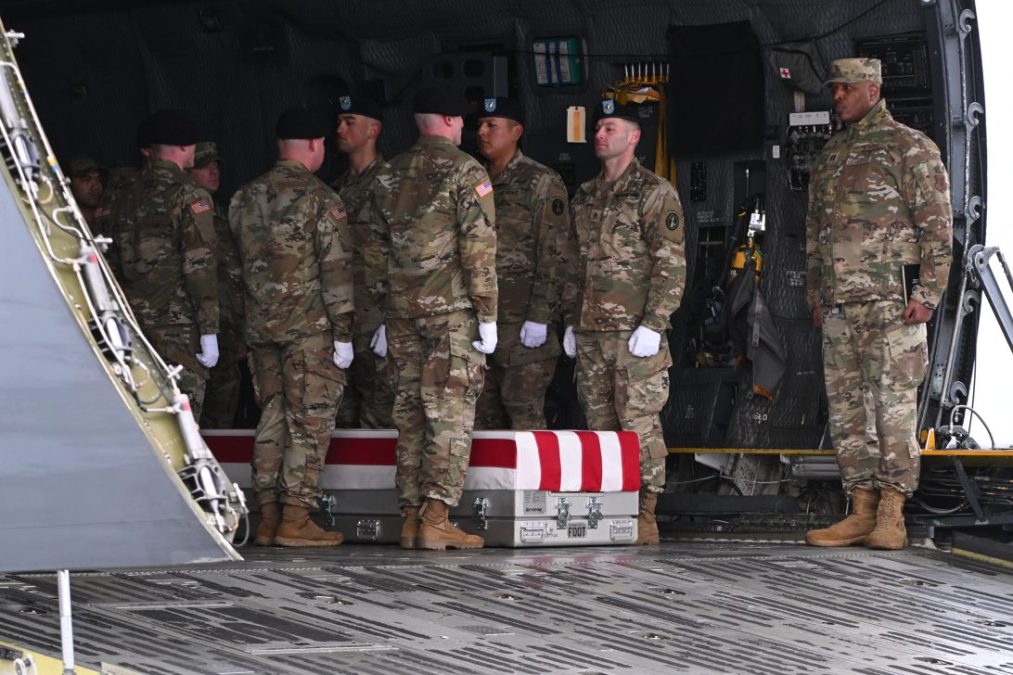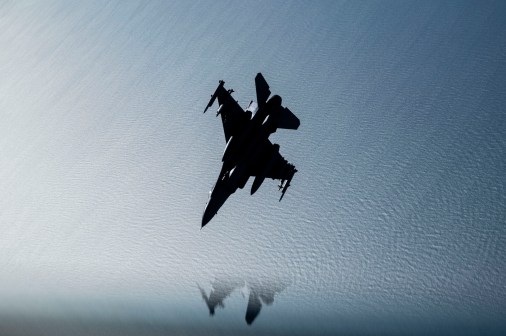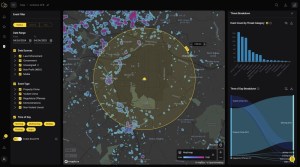‘Stark reminders’: Experts assess how military tech must adapt after deadly drone attack on US troops

After a one-way enemy attack drone killed three American troops and hurt dozens more in Jordan on Jan. 28, former defense officials and other experts are urging Pentagon leaders to more hastily deploy technologies that can sense and counter such weapons that are progressively threatening U.S. assets in the Middle East and elsewhere.
“This incident is absolutely not a fluke. U.S. military personnel and infrastructure — both abroad and at home — are going to be exposed to drone attacks, and we can expect the sophistication of the technology and tactics to increase,” Caitlin Lee, director of RAND’s Acquisition and Technology Policy Program, told DefenseScoop this week.
Led by U.S. Central Command, the Defense Department’s investigation is ongoing and government officials have not yet shared a full assessment of what happened in the strike.
But according to initial reports, a kamikaze drone flew near service members’ living quarters at a small base in Jordan called Tower 22 at the same time as a U.S. surveillance drone — and essentially confused American forces, resulting in no air defenses being deployed.
“Our teammates were killed by radical militias backed by Iran and operating inside Syria and Iraq. In the aftermath of the vile Hamas terrorist assault on Israel on October 7th, terrorist groups backed by Iran and funded by Iran have tried to create even more turmoil, including the Houthis attacking commercial shipping in the Red Sea,” Defense Secretary Lloyd Austin told reporters during a Pentagon press briefing on Thursday.
“This particular attack was egregious in that, you know, the attack was on the sleeping area of … our base. And again, Kata’ib Hezbollah and other elements continue to attack our troops. And again, I think, at this point we should — it’s time to take away even more capability than we’ve taken in the past,” Austin said.
In separate discussions with DefenseScoop this week, four defense experts shed light on the state of America’s sensing and air defense capabilities, and how global war on terrorism (GWOT) technologies might need to be adapted or enhanced to thwart the increasing sophistication of adversaries’ weapons and forces.
‘A threat we must respect’
For Patrick “Krown” Killingsworth, director of autonomy product at EpiSci, the “loss” associated with the Jan. 28 drone assault is heartbreaking and “has a personal poignancy.”
“As a former USAF F-15C and F-22 pilot I was a member of an air dominance community that dedicated their lives to protecting American and allied forces from aerial attack. We took an immense amount of pride in the fact that no U.S. forces had been killed by enemy air action since April 15th, 1953,” Killingsworth told DefenseScoop.
Building on prior expertise as an Air Force fighter pilot and test pilot, Killingsworth now works to help deliver trusted autonomy solutions for the DOD.
To him, this latest attack in Jordan demonstrates that while the U.S. must maintain advantage against high-end threats, the tactical capabilities of widely proliferated drones must also be taken very seriously at this time.
“Unmanned aerial systems pose a threat that is a significant departure from those that we’ve historically been concerned with — but will be a characteristic of any future conflict and the U.S. must invest in the resources to prepare for the future fight,” Killingsworth said.
“Also, I would point out that we should not yet classify the drone as ‘undetected,’ all that’s clear now is that it wasn’t successfully intercepted,” he added.
The experts who spoke to DefenseScoop generally agreed that what happened on Jan. 28 can be considered representative of the rapidly evolving technologies that are being deployed in a range of different conflict areas.
“This is not something we should categorize as a one-off attack. The capability for similar attacks in the region almost certainly exists — it’s a threat we must respect. The combat utility of these systems is undeniable, and the United States must make sure that we too take advantage of capabilities they can bring to our own forces,” Killingsworth said.
To Tarek Abdelzaher — a professor of computer science at the University of Illinois’ Grainger College of Engineering, who also leads the Internet of Battlefield Things Alliance — the UAS incident was alarming, particularly “because it shows that an adversary can learn to penetrate our defenses by exploiting our own safety systems against us.”
“In this case, as we now know, the base was expecting a friendly drone at the same time as the enemy drone attacked, which caused hesitation and delayed the reaction to the foreign threat,” he noted. “This is very unfortunate.”
A wide variety of UAS-spotting technologies are already available to the Defense Department.
Capabilities exist that can detect the presence of drones on thermal cameras (because engines are hot), electromagnetic signatures (the fingerprint of drone electronics), or even sound, allowing the defense system to tell a lot about a UAS’ type, speed, and location, according to Abdelzaher. And, the actual detectors and interceptors are not very big — often ranging from something a single soldier can carry to larger vehicle-mounted and shipboard systems.
“Drone detection is the easy part. The harder problem is to automatically tell with confidence whether this is a friend or a foe, when both are present simultaneously,” he said.
In 2021 — pointing to decreased tensions with Iran — the Biden administration removed several air defense systems from multiple Middle East countries.
Still, as of October 2023, the U.S. maintains “a significant air defense presence in the Middle East,” including Terminal High Altitude Area Defense (THAAD) systems in Saudi Arabia, Patriot surface-to-air missile systems in several countries, and deployments of F-16 and other aircraft across the region, Mohammed Soliman, director of the Middle East Institute’s Strategic Technologies and Cyber Security Program, explained.
“Crucially, a vulnerability exists in this deployment: most systems are not currently calibrated to detect kamikaze drones or loitering munitions. Unlike traditional ballistic missiles, these drones fly at lower altitudes and speeds, are smaller and cheaper, and are only detectable at short range,” he said.
That means “industry will need time to develop and deploy new defense systems capable of countering these agile, low-altitude drones,” Soliman told DefenseScoop.
He and some of the other experts suggested that America’s post-9/11 war on terror’s main defense technologies are becoming more and more outdated, and even lagging years behind steady and quickly moving advancements in warfare capabilities.
“Technology advancements haven’t just pushed the boundaries of warfare; they’ve eroded the decades-long monopoly the U.S. held in defense technology, leveling the playing field in worrying ways. Drones epitomize this shift. Cheap, lightweight, targeted, and easily replaced, they pose a significant and often invisible threat. This harsh reality exposes a critical failing: the U.S. military has been, and continues to be, underprepared for the contemporary threat landscape,” Soliman said.
America’s air defense capabilities around the Middle East also include counter-rocket, artillery and mortar (C-RAM) systems.
“C-RAM is a point defense solution for drone attacks, and there are a variety of others for both detection and interdiction,” Lee said.
Lee — a political scientist and longtime researcher of innovation, force planning, emerging technology and organizational culture — explained that it’s typically not difficult to detect very large drones, provided air defense systems are “turned on.”
However, it’s becoming clear that U.S. adversaries will continue to develop new tactics in the near term to evade detection.
“For example, they might closely follow the flight path of friendly drones on approach,” Lee said, noting that air defenses at times may be turned off when friendly aircraft are expected to land, creating an opportunity for adversary aircraft to follow closely behind.
“Small commercial-derivative drones — like the ones used in Ukraine — pose a much harder detection and interdiction challenge. Air defense radars were all originally designed to detect large, fast aircraft — not low-flying, slow and small drones that look like birds or a variety of other flying objects. And even when anti-aircraft systems detect small drones, the cost of shooting them down is much higher than the cost of the drone itself, creating a very unsustainable and unfavorable cost-exchange ratio,” Lee said.
“The problem is only going to get harder as adversaries start to deploy drone swarms, which could potentially overwhelm air defenses,” she noted.
What is needed
America’s relationship with Iran is evolving, complex and historically tense.
“Iran seeks to operate under a cloak of plausible deniability, providing money, weapons and training to militant groups in the Middle East who share Tehran’s opposition to U.S. interests and objectives in the region. Unmanned systems are perfect weapons to ensure that plausible deniability, and Iran is a top supplier of these weapon systems,” Lee explained.
The Iranian military backs and equips dozens of militias in the region. But at this point, it’s still unclear how much of a role Iran played in the actual execution of the Jan. 28 attack on U.S. forces.
“Iran’s interests may not always be completely aligned with these militant groups, but so far it has not been willing to turn off the spigot, either, and we can expect militant groups to continue to capitalize on this,” Lee said.
“China and Turkey are also major drone exporters in the region. Drones are relatively low-cost and easy to operate, making them a weapon of choice for middle powers, non-state actors and individuals who seek to maximize the lethality on a budget. So we can expect to see the global market for combat-capable drones — both military grade and commercially derivative — to continue to grow,” she also noted.
As tensions in and around the Red Sea show no signs of immediately waning, Iran and its proxies are also posing significant cyber threats to U.S. interests, according to some analysts.
“As the conflict in Gaza persists, and considering Iran’s recent attack on American forces in Jordan and the impending U.S. response, the risk of cyber attacks on U.S. networks and infrastructure — both domestically and internationally — is set to escalate sharply. Iran-based cyberattacks have already jeopardized water and wastewater facilities in several U.S. states by exploiting vulnerabilities in computer systems manufactured by Israel that operate these facilities,” Soliman said.
DefenseScoop asked experts to share suggestions regarding how the U.S. should confront these modern technological threats.
Abdelzaher argued that this incident showcases the importance of having advanced and trustworthy artificial intelligence in the battlefield that can make fast, safe and accurate decisions about threats.
“Weaponized kamikaze drones are becoming a more commonplace tool in today’s conflicts. They significantly reduce the time available for decision-making from when they are detected and before they hit their target. We already have the capability to quickly respond to such threats. The problem is that we do not want a repeat of the ‘Uber story’ when an autonomous car hit a pedestrian because it misidentified them. Therefore, a conservative approach is taken – when in doubt, don’t shoot. Better AI can remove the doubt,” he said.
Lee recommended that the U.S. work to get “left of launch” by targeting emerging drone and missile proliferation networks, like UAS makers, suppliers, and trainers, before future attacks are launched.
“The U.S. has tried to do some of this in response to the Houthi attacks on commercial shipping in the Red Sea, but that is too little too late. What is needed is a systematic, prolonged U.S.-led campaign to go after drone and missile proliferation networks before they result in attacks. The left of launch approach could involve targeted attacks on drone manufacturers or launch sites, but it could also involve non-kinetic solutions: cyber attacks, interdicting supply lines, and working with allies and partners to crack down on third party drone part suppliers,” Lee said.
In terms of America’s response, she and all the experts DefenseScoop spoke to suggested that while the Pentagon has started to invest in counter-UAS technologies, much more is needed.
“To date, many counter-drone solutions focus on modifying air defense systems to detect and intercept drones. While these are good point solutions, the cost exchange ratio is not favorable. The U.S. needs to consider rapidly fielding lower-cost, more effective solutions in the realms of electromagnetic warfare and laser weapons,” Lee noted.
In Soliman’s view, although the U.S. possesses advanced UAS technology, “its utilization and development have yet to keep pace with the threat landscape.”
“The underinvestment in sensing and counter-UAS technologies leaves vulnerabilities that adversaries can exploit. The recent conflicts in the Middle East serve as stark reminders of this strategic gap,” he said.
Killingsworth, too, stated that the Tower 22 attack spotlights a need for the American military to invest in more robust solutions that can be leveraged and adapted to counter innovations in drone technology in real-time.
“Without a doubt this attack will be studied by a large number of U.S. military tacticians. My hope is that we will understand and apply any lessons learned so that the date of January 28, 2024 is remembered for future generations of air superiority practitioners as the final time that U.S. forces were attacked by an enemy aircraft,” the former Air Force pilot told DefenseScoop.






